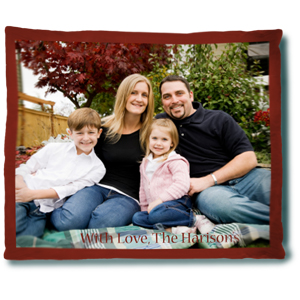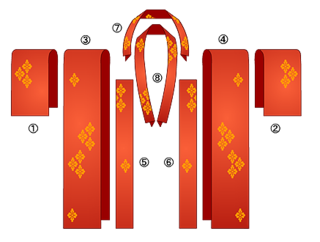
Variegated yarn is yarn dyed with more than one colour. [1] [2]

Variegated yarn is yarn dyed with more than one colour. [1] [2]
It can produce effects that vary depending on the technique of the crafter, the pattern used, and the frequency of colour change. These effects include "flashing" (lightning-bolt effects) and "pooling" (patchy or marbleized effects). Some yarns (known as "self-striping yarns") are designed to produce stripes when used to knit small items such as socks or mittens.
In solid dyeing, yarns dyed in one single color, Variegated yarns have more than one color. [2] There are various methods of applying two or more colors, and the most common practice is spray or space dyeing.
Space dyeing is a technique of localized color application that produces a unique multicolored effect. [3] [4]
Variegated yarns may be used also in knitting, crocheting, and other textile arts. These variegated colored yarns help in making small fancy items such as braids, etc. [5] [6]

Crochet is a process of creating textiles by using a crochet hook to interlock loops of yarn, thread, or strands of other materials. The name is derived from the French term crochet, meaning 'small hook'. Hooks can be made from a variety of materials, such as metal, wood, bamboo, or plastic. The key difference between crochet and knitting, beyond the implements used for their production, is that each stitch in crochet is completed before the next one is begun, while knitting keeps many stitches open at a time. Some variant forms of crochet, such as Tunisian crochet and broomstick lace, do keep multiple crochet stitches open at a time.

Knitting is a method by which yarn is manipulated to create a textile, or fabric. It is used to create many types of garments. Knitting may be done by hand or by machine.

A textile is a flexible material made by creating an interlocking bundle of yarns or threads, which are produced by spinning raw fibers into long and twisted lengths. Textiles are then formed by weaving, knitting, crocheting, knotting, tatting, felting, bonding, or braiding these yarns together.
Yarn is a long continuous length of interlocked fibres, suitable for use in the production of textiles, sewing, crocheting, knitting, weaving, embroidery, or ropemaking. Thread is a type of yarn intended for sewing by hand or machine. Modern manufactured sewing threads may be finished with wax or other lubricants to withstand the stresses involved in sewing. Embroidery threads are yarns specifically designed for needlework.

Textile arts are arts and crafts that use plant, animal, or synthetic fibers to construct practical or decorative objects.
Ikat is a dyeing technique originating from Indonesia used to pattern textiles that employs resist dyeing on the yarns prior to dyeing and weaving the fabric.

Dyeing is the application of dyes or pigments on textile materials such as fibers, yarns, and fabrics with the goal of achieving color with desired color fastness. Dyeing is normally done in a special solution containing dyes and particular chemical material. Dye molecules are fixed to the fiber by absorption, diffusion, or bonding with temperature and time being key controlling factors. The bond between dye molecule and fiber may be strong or weak, depending on the dye used. Dyeing and printing are different applications; in printing, color is applied to a localized area with desired patterns. In dyeing, it is applied to the entire textile.

Textile manufacturing is a major industry. It is largely based on the conversion of fibre into yarn, then yarn into fabric. These are then dyed or printed, fabricated into cloth which is then converted into useful goods such as clothing, household items, upholstery and various industrial products. Overall, many things can be made with cotton, not just clothing.

Kasuri (絣) is the Japanese term for fabric that has been woven with fibers dyed specifically to create patterns and images in the fabric, typically referring to fabrics produced within Japan using this technique. It is a form of ikat dyeing, traditionally resulting in patterns characterized by their blurred or brushed appearance.
The manufacture of textiles is one of the oldest of human technologies. To make textiles, the first requirement is a source of fiber from which a yarn can be made, primarily by spinning. The yarn is processed by knitting or weaving, which turns yarn into cloth. The machine used for weaving is the loom. For decoration, the process of colouring yarn or the finished material is dyeing. For more information of the various steps, see textile manufacturing.

In clothing, heather refers to a color effect created by mixing two or more different colored fibers or yarns. It is interwoven yarns of mixed colors, and possibly the type of fiber, producing another color. It is typically used to mix multiple shades of grey or grey with another color to produce a muted shade, but any two colors can be mixed, including bright colors. A mixed fabric color is achieved by using different colors of fiber and mixing them together. Black and white fiber mixed will combine to give grey heather fiber. Heather is blended fibers combined to create a multicolored effect. Heather effect is also known as melange effect.

Novelty yarns include a wide variety of yarns made with unusual features, structure or fiber composition such as slubs, inclusions, metallic or synthetic fibers, laddering and varying thickness introduced during production. Some linens, wools to be woven into tweed, and the uneven filaments of some types of silk are allowed to retain their normal irregularities, producing the characteristic uneven surface of the finished fabric. Man-made fibres, which can be modified during production, are especially adaptable for special effects such as crimping and texturizing.

In textile manufacturing, finishing refers to the processes that convert the woven or knitted cloth into a usable material and more specifically to any process performed after dyeing the yarn or fabric to improve the look, performance, or "hand" (feel) of the finish textile or clothing. The precise meaning depends on context.

A photo blanket is a large, rectangular piece of fabric displaying images, pictures, or designs, often with bound edges, used as a blanket or decorative object. Historically photo blanket were made of thick cloth depicting people, objects, and symbols intended to tell a story or reveal historical events.

Natural dyes are dyes or colorants derived from plants, invertebrates, or minerals. The majority of natural dyes are vegetable dyes from plant sources—roots, berries, bark, leaves, and wood—and other biological sources such as fungi.

Dyeing is the craft of imparting colors to textiles in loose fiber, yarn, cloth or garment form by treatment with a dye. Archaeologists have found evidence of textile dyeing with natural dyes dating back to the Neolithic period. In China, dyeing with plants, barks and insects has been traced back more than 5,000 years. Natural insect dyes such as Tyrian purple and kermes and plant-based dyes such as woad, indigo and madder were important elements of the economies of Asia and Europe until the discovery of man-made synthetic dyes in the mid-19th century. Synthetic dyes quickly superseded natural dyes for the large-scale commercial textile production enabled by the industrial revolution, but natural dyes remained in use by traditional cultures around the world.

Eisaku Noro Company, Ltd. is a yarn manufacturer located in the Aichi Prefecture of Japan. The company produces yarns for handcrafting under the Noro brand name, as well as machine yarns for textile production using the Eisaku Noro label. The company was founded over forty years ago by Eisaku Noro. The handcrafting yarns in particular are well known for their vivid colors and combinations of diverse fiber types. They differ from a number of other manufactured yarns in the industry by having lengthier spans of color in the runs, causing distinctive striping patterns, as well as being partially spun by hand versus being produced completely by machines. In 2012, Noro Knitting Magazine initiated publication, which features knit and crochet patterns specifically designed for use with the yarns.
Wet process engineering is one of the major streams in textile engineering which refers to the engineering of textile chemical processes and associated applied science. The other three streams in textile engineering are yarn engineering, fabric engineering, and apparel engineering. The processes of this stream are involved or carried out in an aqueous stage. Hence, it is called a wet process which usually covers pre-treatment, dyeing, printing, and finishing.

A tanmono is a traditional Japanese narrow-loomed cloth. It is used to make traditional Japanese clothes, textile room dividers, sails, and other traditional cloth items.
A blend is an intimate mixture of two or more fibers. In yarn spinning, different compositions, lengths, diameters, or colors may be combined to create a blend. The term, blend, refers to spun fibers or a fabric composed of such fibers. There are several synonymous terms: a combination yarn is made up of two strands of different fibers twisted together to form a ply; a mixture or mixed cloth refers to blended cloths in which different types of yarns are used in warp and weft sides.